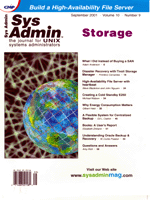
Article
Figure 1
Figure 2
Figure 3
Figure 4
Figure 5
Figure 6
Figure 7
Figure 8
Figure 9
Figure 10
Figure 11
Listing 1
Listing 2
Listing 3
Listing 4
Sidebar 1
Sidebar 2
Sidebar 3
Table 1
Table 2
Table 3
Table 4
|
Parameters-r -- "r" is the minimum number of pages that need to be read sequentially before the VMM detects a sequential read. I have this set to 2. For example, after the VMM detects two sequential page reads from disk, it will start pre-fetching pages up to "R" number of pages. -R -- "R" is the maximum number of pages that will be read ahead. Unless you don't want this behavior, set "R" large (i.e., 64 or 128). There is no harm in setting it larger than your hardware can handle. I have this set to 64. -f -- "f" is the lower limit of free real memory pages. When the free list hits this number, the VMM starts to free real memory pages. IBM recommends that this number be 120 times the number of CPUs you have. I would try different combinations to see what gives you the best performance. Most of my boxes have this set at 256. -F -- "F" is the upper limit of free real memory pages. When the VMM is freeing real memory pages and hits this limit, it stops. "F" should be at least f + ( R x 4096 ). "f" and "R" are from above, 4096 is the page size. This guarantees that there will be enough free memory for a large disk read. I follow this for all of my servers, but recommend trying different values to see what gives the best performance. -h -- Setting "h" to "1" (one) will enforce maxperm (the maximum percentage of physical memory that can be used for file caching). I had to set this on my production nodes because they were using too much real memory (8-10 GB) for file caching. Managing this amount of file cache was causing the HACMP daemons to time out and causing HACMP to think the node had failed.
Do not change these parameters on the fly -- especially on a production machine because it may have disastrous effects. I recommend changing them in /etc/rc.local. |